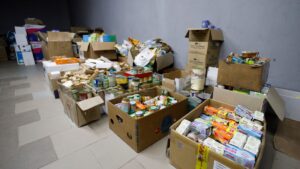
The United Nations in Ukraine, in coordination with the government, has established a flexible Ukraine Community Recovery Fund (UCRF), which has already attracted $7.25 million for mine action.
“The fund is designed to support an inclusive, locally-driven approach that is fully aligned with the early recovery priorities identified in the third Rapid Damage and Needs Assessment (RDNA-3),” the UN website says in a presentation of the fund’s mine action.
It is specified that the UCRF, established in November 2023, is expected to raise $300 million over five years. By the beginning of May this year, $11.74 million had been received, including $7.25 million for demining: Denmark – $5.76 million (DKK40 million) and South Korea – $1.25 million.
It is emphasized that mine action is a key condition for the restoration of housing, energy, social infrastructure and investment in local economic development at the community level. The full-scale invasion of Ukraine by the Russian Federation has led to the fact that up to 30% of the country’s territory is likely to be contaminated with unexploded ordnance, landmines and cluster munitions.
According to UN materials, the first mine action project of the fund will be the construction of a logistics base for humanitarian demining for the SES. The feasibility study, designs for all necessary works and site preparation are estimated at $1.18 million. With separate funding for the second phase, construction can be completed by the second quarter of 2025.
It is expected that this facility will significantly increase the efficiency and effectiveness of SES demining operations throughout Ukraine and enable it to better defuse explosive ordnance in affected communities.
It is also planned to establish the position of a senior advisor on mine action and community recovery, who will advise all stakeholders on improving the effectiveness of mine action for affected communities.
It is noted that the UCRF Mine Action Window is a tool through which the UN will stimulate strategic mine action efforts, address gaps in needs in targeted communities and pilot innovative mine action initiatives.
According to the RDNA-3, an investment of at least $300 million per year over the next five years is required for explosive ordnance survey and clearance. To sustain this level of financial commitment, national and international partners will need to work together to maximize the effectiveness of traditional mine action approaches, while implementing cost-effective, high-impact solutions and considering private partnerships as a way forward.
“UCRF’s Mine Action Window is aligned with the Government of Ukraine’s National Mine Action Strategy and focuses on its three pillars – demining, mine action training and victim assistance.
The UCRF Secretariat is located in the Office of the UN Resident Coordinator in Kyiv.

The war in Ukraine has displaced some four million people, and while the country’s humanitarian needs are increasing, the amount of humanitarian aid is shrinking, said Caroline Lindholm Billing, representative of the UN High Commissioner for Refugees in Ukraine, Voice of America reported.
“There are far fewer resources for humanitarian assistance because the humanitarian needs are actually increasing because of these events. It is the most vulnerable people who will be the ones who will suffer from reduced funding and support,” Billing said.
According to her, the UN humanitarian plan for Ukraine for 2024 is $3.1 billion, including $599 million for the UN Refugee Agency. However, both the global response plan and the UN appeal were only 15 percent funded in the first quarter of this year, compared to 30 percent in the same period last year.
As the conflict drags on, turning into an “ultramarathon,” according to Billing, she added that “monetary and humanitarian assistance – in the form of providing goods and services, assistance with shelter, home repair, psychosocial support” is now “less frequent and less predictable.”
She emphasized the consequences of the Russian offensive in eastern Kharkiv Oblast, which has often left countless civilians without basic necessities such as electricity and water supplies.

The King Salman Center for Rescue and Humanitarian Assistance (KSRelief) has donated $10 million to the United Nations World Food Program (WFP). King Salman Rescue and Humanitarian Relief Center (KSRelief) has donated $10 million to the United Nations World Food Program (WFP) to support war-affected Ukrainians in 1,200 facilities across the country with daily hot meals, according to the WFP press office.
“We are grateful to KSRelief for supporting a vital component of our emergency assistance programs in Ukraine that supports the most vulnerable Ukrainians and strengthens the local institutions and organizations that care for them,” said Marianne Ward, acting director of WFP Ukraine.
According to a press release, the agreement was signed between H.E. Dr. Abdullah Al Rabia, Advisor to the Royal Court and General Manager of KSRelief, and WFP Executive Director Cindy McCain.
Saudi Arabia’s contribution will help provide 50 million meals to the institutions that WFP supports (hospitals, shelters for internally displaced persons, orphanages, neuropsychiatric and geriatric institutions, and other public or private organizations that care for vulnerable Ukrainian citizens).
“We are pleased to be part of this important emergency program to respond to the urgent humanitarian needs of the affected population in Ukraine. KSrelief’s humanitarian assistance will provide vital food aid to the most vulnerable communities across the country,” the press office quoted KSRelief’s Assistant General Manager for Planning and Development, Ahmed Al Baiz, as saying.
The assistance provided will allow the purchase and delivery of about 7,600 tons of food. It is noted that all products, including flour, pasta, buckwheat, oatmeal, peas, sugar and oil, are purchased from Ukraine to support the local economy and food system.
Over the next six months, WFP’s institutional feeding program plans to provide food assistance to 210,000 vulnerable Ukrainians. KSRelief’s contribution will cover a significant portion of the program’s needs – approximately 67%. This is support for 140 thousand people.
During 2023, WFP’s institutional feeding program supported 460,000 Ukrainians in Cherkasy, Chernihiv, Chernivtsi, Dnipropetrovsk, Donetsk, Ivano-Frankivsk, Kharkiv, Kherson, Khmelnytskyi, Kirovograd, Kyiv, Lviv, Mykolayiv, Odessa, Poltava, Rivne, Sumy, Ternopil, Vinnytsia, Volyn, Zakarpattya, Zaporizhzhya and Zhytomyr regions.
Institutional feeding is one of the many ways WFP supports Ukrainians affected by the war. WFP is also distributing food packages in areas close to the front line where food is hard to find or very expensive, distributing cash assistance to vulnerable Ukrainians across the country, and supporting the safe release of agricultural land mines in Kharkiv Oblast to help farmers and food producers. WFP has also chartered 25 ships to export Ukrainian grain to countries in need through the Black Sea Grain Initiative and Grain from Ukraine.
The United Nations World Food Programme is the world’s largest humanitarian organization that saves lives in emergencies and uses food aid to build a path to peace, stability and prosperity for people recovering from conflict, natural disasters and the effects of climate change.

Approximately 1.05 billion tons, or 19% of all food produced in the world, was wasted in 2022, while more than 780 million people continued to struggle with hunger, the UN says.
“In 2022, households on all continents wasted more than 1 billion meals a day, while 783 million people suffered from hunger and a third of the world’s population faced food insecurity,” the report, published on the website of the United Nations Environment Programme (UNEP), says.
According to the report, in 2022, the world produced 1.05 billion tons of food waste, which is 132 kg per capita or almost a fifth of all food available to consumers. Households accounted for 60% of food waste, catering companies for 28%, and retailers for another 12%.
“Food waste is a global tragedy. Today, millions of people are starving while food is simply thrown away,” said UNEP Executive Director Inger Andersen.
“Such waste causes significant damage to the climate and nature,” she added.
According to the UNEP, food waste is responsible for 8-10% of annual global greenhouse gas emissions and significant biodiversity losses.
“The damage to the global economy from food losses and food waste is estimated at about $1 trillion,” UNEP said.
The report emphasizes that as of 2022, only 21 countries have included reducing food loss and food waste in their national climate agenda.

More than 14.6 million people in Ukraine are in need of humanitarian assistance, and Ukrainian refugees who fled the country due to the war also need help, the UN website reported on January 9.
“This year, according to UN estimates, more than 14.6 million people in Ukraine – 40 percent of the country’s population – will need humanitarian assistance. The UN also reminds that 6.3 million Ukrainians who fled abroad need help,” the publication says.
It is noted that next Monday, the UN Office for the Coordination of Humanitarian Affairs (OCHA), together with the UN Refugee Agency (UNHCR), will present a 2024 response plan for Ukraine, as well as for Ukrainian refugees and host countries in the region in Geneva.
UNHCR expresses concern that many Ukrainian refugees remain without the necessary support.
The UN welcomes the European Union’s decision to extend temporary protection measures for Ukrainian refugees until March 2025, while emphasizing that efforts to integrate IDPs into the national systems of host countries should be a priority.

The United Nations (UN) is requesting $435 million in humanitarian aid for Ukraine to help it get through the winter, the Ministry of Reintegration of the Temporarily Occupied Territories of Ukraine reports, citing the UN Office.
“In connection with the adjustment of the Humanitarian Response Plan, the UN asks partners to allocate $435 million in assistance to Ukraine. This is stated on the website of the United Nations Office for the Coordination of Humanitarian Affairs (OCHA Ukraine),” the Ministry of Reintegration said in a statement on its Telegram channel on Tuesday.
The UN believes that these funds will make it possible to provide humanitarian assistance to more than 1.7 million people throughout Ukraine until March 2024.
As noted, the relevant Humanitarian Response Plan is being implemented in support of the efforts of the Government of Ukraine, as well as national, regional and local authorities. In the future, it will be supplemented by a regular program designed to meet the needs of more than 11 million Ukrainians.
The 2023-2024 response will focus on communities where active hostilities have taken place or are taking place, namely in Donetsk, Dnipro, Kharkiv, Kherson, Luhansk, Mykolaiv, Sumy and Zaporizhzhia oblasts.